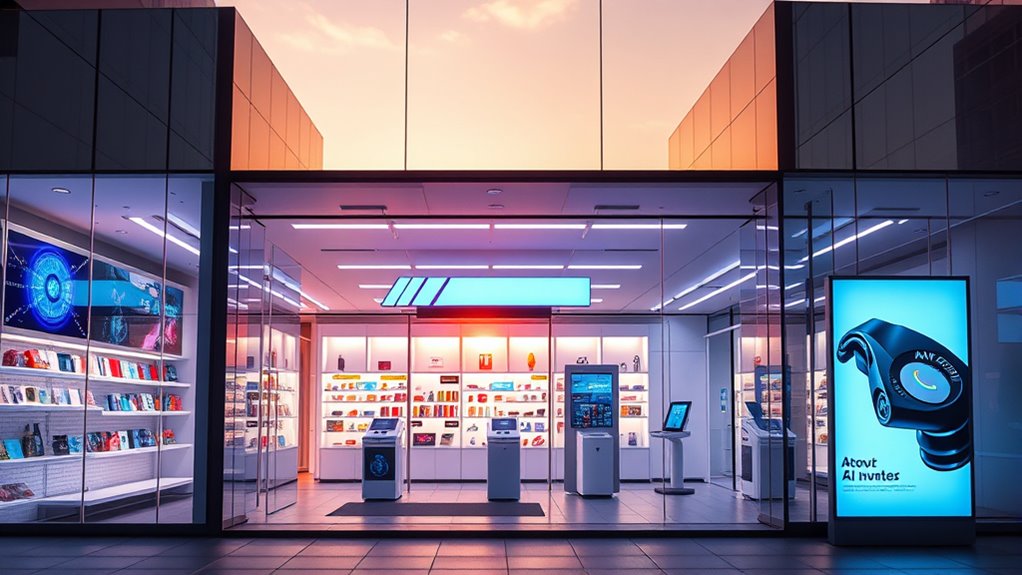Self-operating shops powered entirely by AI are revolutionizing retail by removing barriers like checkout lines and manual inventory management. Using computer vision, robots, and real-time data, these stores can track items, manage stock, and personalize your shopping experience seamlessly. With AI-driven customer engagement and smart store operations, shopping becomes faster, smarter, and more efficient. If you keep exploring, you’ll discover how these innovations are shaping the future of retail innovation.
Key Takeaways
- Autonomous checkout systems enable seamless, cashier-less shopping experiences through real-time computer vision and AI-driven transaction processing.
- Shelf-scanning robots maintain optimal inventory levels, reducing stock errors and ensuring shelves are always well-stocked.
- AI analytics optimize store operations and monitor customer behavior to enhance efficiency, security, and personalized service.
- Personalized marketing strategies driven by AI increase sales and customer engagement through targeted recommendations and promotions.
- Virtual AI assistants and interactive tools provide real-time support, guidance, and product visualization, transforming retail into a self-operating environment.

Have you ever wondered how stores are becoming smarter and more automated? It’s because AI is transforming every aspect of retail, making shopping quicker, more personalized, and more efficient. Autonomous checkout systems, like Amazon Go, use computer vision to track what you pick up and automatically charge your account, eliminating the need for cashiers. Shelf-scanning robots at places like Walmart patrol the aisles, identifying out-of-stock items, correcting pricing errors, and finding misplaced goods faster and more accurately than humans ever could. This not only speeds up inventory management but also reduces mistakes, ensuring shelves are well-stocked and prices are correct. Autonomous decision-making creates a seamless shopping environment where systems continuously adapt to real-time data to enhance operational efficiency.
AI-powered stores automate inventory and checkout, making shopping faster, smarter, and more accurate.
Additionally, AI-driven inventory management systems leverage asset division strategies to optimize stock levels, reducing waste and improving supply chain logistics. You can also skip the checkout line altogether by using AI-powered mobile apps at stores like Target. Just scan items with your phone, pay instantly, and save up to 60% in wait times. These apps even analyze your shopping behavior to prevent theft and optimize your experience. Meanwhile, AI-driven management platforms work behind the scenes, autonomously adjusting staffing levels, managing inventory, and optimizing store operations to run smoothly. Real-time video analytics monitor customer behavior, helping store layouts be more inviting and secure.
In addition, AI is personalizing your shopping experience through targeted recommendations and upsells based on your browsing and purchase history. Platforms like Shopify and Starbucks send you tailored promotions considering factors like weather, location, and time, boosting sales considerably. Nordstrom’s AI systems even customize newsletters with ideal content, increasing customer engagement. These personalized offers can raise your average order size by about 25%, often with minimal effort from the store.
AI shopping assistants and virtual agents are now guiding you through product choices with emotional intelligence and real-time insights. They anticipate your needs based on your behavior, making your shopping seamless across websites, apps, and messaging platforms. These AI agents answer questions, suggest relevant products, and reduce the frustration of searching, increasing your chances of finding exactly what you want.
AI automates inventory management with robots that scan shelves multiple times faster than humans, updating stock levels instantly. This helps prevent stockouts and ensures the right products are always available. Virtual try-on apps like NEONAIL use computer vision to show how products look on you, boosting engagement and conversions. Overall, AI-powered stores are reshaping retail into a fully self-operating landscape, making shopping faster, smarter, and more personalized than ever before.
Frequently Asked Questions
How Secure Are Ai-Operated Payment Systems?
AI-operated payment systems are becoming more secure, thanks to advanced fraud detection and behavioral biometrics that identify suspicious activity quickly. You benefit from faster breach response and improved data protection through encryption and access controls. However, you should stay cautious, as vulnerabilities still exist from cybercriminals using AI for sophisticated attacks, and the lack of strong governance can increase risks. Regular updates and rigorous security measures are essential to keep your payments safe.
What Happens During System Malfunctions or Outages?
During system malfunctions or outages, your shop’s automated processes stop functioning properly. You might experience issues like incorrect item identification at checkout, compromised theft detection, and inaccurate inventory data. To manage this, you’ll need to rely on manual interventions, such as staff stepping in to assist customers or handle security. Regular maintenance, backup systems, and staff training are essential to minimize downtime and keep operations running smoothly despite technical failures.
How Do Shops Handle Customer Service Inquiries?
You’ll find that shops handle customer service inquiries through AI-powered chatbots and automated systems. These tools quickly answer common questions, process orders, and troubleshoot issues, often deflecting up to 70% of inquiries. When complex problems arise, human agents step in to provide personalized support. This seamless integration guarantees faster resolutions, maintains customer satisfaction, and reduces operational costs, allowing you to enjoy efficient, around-the-clock service without long waits.
Are Ai-Operated Shops Compliant With Local Regulations?
Think of AI shops as tightrope walkers balancing regulations. You’ll find they can be compliant, but only if you actively manage the complex rules across federal, state, and local levels. You must make certain transparency, protect data privacy, and conduct regular audits for bias and fairness. Using advanced compliance tools and fostering a team with legal, technical, and operational expertise helps you stay steady and avoid costly penalties.
How Is Customer Data Protected in These Shops?
You’re protected in these shops because they use data anonymization, encryption, and behavior analysis to keep your personal information secure. They implement strict cybersecurity measures and regularly audit their systems to prevent breaches. Transparency is key, so they notify you about data collection and offer options to control your data. By balancing security with privacy, these shops aim to safeguard your information while providing seamless, AI-driven service.
Conclusion
As you step into these AI-driven shops, you’re entering a new dawn where technology and humanity dance in harmony. The shelves hum with the quiet promise of innovation, ready to serve without pause. This isn’t just shopping; it’s a glimpse into a future where automation whispers the song of endless possibility. Embrace the revolution, for you’re witnessing the dawn of a world where machines don’t replace us—they elevate us to new heights.











